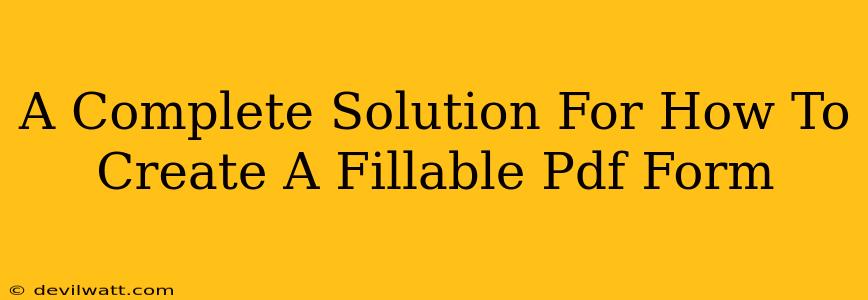Creating fillable PDF forms might sound intimidating, but it's surprisingly straightforward! This guide provides a complete solution, walking you through various methods, from simple online tools to more advanced software options. Whether you need a quick form for collecting basic information or a complex document for detailed data entry, we've got you covered.
Understanding Fillable PDF Forms
Before diving into the how, let's understand the why. Fillable PDF forms offer several advantages:
- Easy Distribution: Share forms electronically via email, websites, or online platforms. No more printing, faxing, or scanning!
- Automated Data Collection: Data is entered directly into the form's fields, streamlining data entry and reducing errors.
- Organized Data Storage: Collected data is neatly organized within the PDF itself, making it easy to manage and analyze.
- Professional Appearance: Fillable PDFs present a clean, professional image, enhancing your brand.
Methods for Creating Fillable PDF Forms
Now for the fun part – actually creating your form! Here are several effective methods:
Method 1: Using Online Form Builders
Several websites offer free or paid services for creating fillable PDFs. These typically involve a user-friendly interface, requiring no special software. Many offer additional features like integrations with other services or advanced form logic. This is a great option for beginners and those needing quick, simple forms.
Pros: Easy to use, no software installation needed, often offers collaborative features.
Cons: May have limitations on features or customization options, potential subscription costs for advanced features.
Method 2: Leveraging PDF Editors
Dedicated PDF editors offer robust tools for creating complex fillable forms. These programs usually provide a wider range of customization options, allowing for advanced features like calculations, conditional logic, and digital signatures.
Features to Look For in a PDF Editor:
- Form Field Creation Tools: Easy-to-use interfaces for adding text fields, checkboxes, radio buttons, dropdowns, and more.
- Form Validation: Features to ensure data integrity, such as mandatory fields or data type validation.
- Customization Options: Ability to adjust font styles, colors, and the overall layout of your form.
- Digital Signature Support: Allow recipients to electronically sign the form.
Method 3: Using Spreadsheet Software (Advanced)
Believe it or not, spreadsheet programs like Microsoft Excel or Google Sheets can also be used to create fillable PDF forms. This method requires more technical knowledge but provides excellent control over your form's structure and design. You'll need to save the spreadsheet as a PDF; the fillable fields will often translate correctly. This requires testing to ensure proper functionality.
Pros: High degree of customization and control if you are familiar with spreadsheets.
Cons: Requires technical skills, may not be the best option for beginners.
Tips for Designing Effective Fillable PDF Forms
No matter which method you choose, follow these tips to design effective forms:
- Clear Instructions: Provide clear and concise instructions on how to fill out the form.
- Logical Flow: Arrange fields in a logical order to simplify completion.
- Consistent Formatting: Maintain a consistent font, size, and spacing throughout the form.
- Accessibility: Use descriptive labels for form fields and ensure the form is accessible to people with disabilities.
- Testing: Always test your form thoroughly before distributing it to ensure it functions correctly and data is captured effectively.
Conclusion: Choose Your Path to Fillable PDF Mastery!
Creating fillable PDF forms opens a world of possibilities for streamlining your workflows and enhancing data collection. From simple online tools to powerful PDF editors, the method you choose depends on your technical skills and the complexity of your form needs. By following the steps and tips outlined in this guide, you'll be creating professional and efficient fillable PDF forms in no time!

